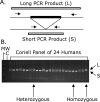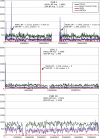An initial map of insertion and deletion (INDEL) variation in the human genome
- PMID: 16902084
- PMCID: PMC1557762
- DOI: 10.1101/gr.4565806
An initial map of insertion and deletion (INDEL) variation in the human genome
Abstract
Although many studies have been conducted to identify single nucleotide polymorphisms (SNPs) in humans, few studies have been conducted to identify alternative forms of natural genetic variation, such as insertion and deletion (INDEL) polymorphisms. In this report, we describe an initial map of human INDEL variation that contains 415,436 unique INDEL polymorphisms. These INDELs were identified with a computational approach using DNA re-sequencing traces that originally were generated for SNP discovery projects. They range from 1 bp to 9989 bp in length and are split almost equally between insertions and deletions, relative to the chimpanzee genome sequence. Five major classes of INDELs were identified, including (1) insertions and deletions of single-base pairs, (2) monomeric base pair expansions, (3) multi-base pair expansions of 2-15 bp repeat units, (4) transposon insertions, and (5) INDELs containing random DNA sequences. Our INDELs are distributed throughout the human genome with an average density of one INDEL per 7.2 kb of DNA. Variation hotspots were identified with up to 48-fold regional increases in INDEL and/or SNP variation compared with the chromosomal averages for the same chromosomes. Over 148,000 INDELs (35.7%) were identified within known genes, and 5542 of these INDELs were located in the promoters and exons of genes, where gene function would be expected to be influenced the greatest. All INDELs in this study have been deposited into dbSNP and have been integrated into maps of human genetic variation that are available to the research community.
Figures



Similar articles
-
The genomic landscape of short insertion and deletion polymorphisms in the chicken (Gallus gallus) Genome: a high frequency of deletions in tandem duplicates.Genetics. 2007 Jul;176(3):1691-701. doi: 10.1534/genetics.107.070805. Epub 2007 May 16. Genetics. 2007. PMID: 17507681 Free PMC article.
-
Genome and gene alterations by insertions and deletions in the evolution of human and chimpanzee chromosome 22.BMC Genomics. 2009 Jan 26;10:51. doi: 10.1186/1471-2164-10-51. BMC Genomics. 2009. PMID: 19171065 Free PMC article.
-
Genome-wide characterization of insertion and deletion variation in chicken using next generation sequencing.PLoS One. 2014 Aug 18;9(8):e104652. doi: 10.1371/journal.pone.0104652. eCollection 2014. PLoS One. 2014. PMID: 25133774 Free PMC article.
-
Small insertions and deletions (INDELs) in human genomes.Hum Mol Genet. 2010 Oct 15;19(R2):R131-6. doi: 10.1093/hmg/ddq400. Epub 2010 Sep 21. Hum Mol Genet. 2010. PMID: 20858594 Free PMC article. Review.
-
Insertions and Deletions: Computational Methods, Evolutionary Dynamics, and Biological Applications.Mol Biol Evol. 2024 Sep 4;41(9):msae177. doi: 10.1093/molbev/msae177. Mol Biol Evol. 2024. PMID: 39172750 Free PMC article. Review.
Cited by
-
Nucleotide-resolution profiling of RNA recombination in the encapsidated genome of a eukaryotic RNA virus by next-generation sequencing.J Mol Biol. 2012 Dec 14;424(5):257-69. doi: 10.1016/j.jmb.2012.10.005. Epub 2012 Oct 13. J Mol Biol. 2012. PMID: 23069247 Free PMC article.
-
A 31-bp indel in the 5' UTR region of GNB1L is significantly associated with chicken body weight and carcass traits.BMC Genet. 2020 Aug 26;21(1):91. doi: 10.1186/s12863-020-00900-z. BMC Genet. 2020. PMID: 32847500 Free PMC article.
-
BreakSeek: a breakpoint-based algorithm for full spectral range INDEL detection.Nucleic Acids Res. 2015 Aug 18;43(14):6701-13. doi: 10.1093/nar/gkv605. Epub 2015 Jun 27. Nucleic Acids Res. 2015. PMID: 26117537 Free PMC article.
-
A population model for genotyping indels from next-generation sequence data.Nucleic Acids Res. 2013 Feb 1;41(3):e46. doi: 10.1093/nar/gks1143. Epub 2012 Dec 5. Nucleic Acids Res. 2013. PMID: 23221639 Free PMC article.
-
Human genetics and genomics a decade after the release of the draft sequence of the human genome.Hum Genomics. 2011 Oct;5(6):577-622. doi: 10.1186/1479-7364-5-6-577. Hum Genomics. 2011. PMID: 22155605 Free PMC article. Review.
References
-
- Altshuler D., Pollara V.J., Cowles C.R., Van Etten W.J., Baldwin J., Linton L., Lander E.S., Pollara V.J., Cowles C.R., Van Etten W.J., Baldwin J., Linton L., Lander E.S., Cowles C.R., Van Etten W.J., Baldwin J., Linton L., Lander E.S., Van Etten W.J., Baldwin J., Linton L., Lander E.S., Baldwin J., Linton L., Lander E.S., Linton L., Lander E.S., Lander E.S. An SNP map of the human genome generated by reduced representation shotgun sequencing. Nature. 2000;407:513–516. - PubMed
-
- Bailey J.A., Gu Z., Clark R.A., Reinert K., Samonte R.V., Schwartz S., Adams M.D., Myers E.W., Li P.W., Eichler E.E., Gu Z., Clark R.A., Reinert K., Samonte R.V., Schwartz S., Adams M.D., Myers E.W., Li P.W., Eichler E.E., Clark R.A., Reinert K., Samonte R.V., Schwartz S., Adams M.D., Myers E.W., Li P.W., Eichler E.E., Reinert K., Samonte R.V., Schwartz S., Adams M.D., Myers E.W., Li P.W., Eichler E.E., Samonte R.V., Schwartz S., Adams M.D., Myers E.W., Li P.W., Eichler E.E., Schwartz S., Adams M.D., Myers E.W., Li P.W., Eichler E.E., Adams M.D., Myers E.W., Li P.W., Eichler E.E., Myers E.W., Li P.W., Eichler E.E., Li P.W., Eichler E.E., Eichler E.E. Recent segmental duplications in the human genome. Science. 2002;297:1003–1007. - PubMed
-
- Bennett E.A., Coleman L.E., Tsui C., Pittard W.S., Devine S.E., Coleman L.E., Tsui C., Pittard W.S., Devine S.E., Tsui C., Pittard W.S., Devine S.E., Pittard W.S., Devine S.E., Devine S.E. Natural genetic variation caused by transposable elements in humans. Genetics. 2004;168:933–951. - PMC - PubMed
-
- Berger J., Suzuki T., Senti K.A., Stubbs J., Schaffner G., Dickson B.J., Suzuki T., Senti K.A., Stubbs J., Schaffner G., Dickson B.J., Senti K.A., Stubbs J., Schaffner G., Dickson B.J., Stubbs J., Schaffner G., Dickson B.J., Schaffner G., Dickson B.J., Dickson B.J. Genetic mapping with SNP markers in Drosophila . Nat. Genet. 2001;29:475–481. - PubMed
-
- Bhangale T.R., Rieder M.J., Livingston R.J., Nickerson D.A., Rieder M.J., Livingston R.J., Nickerson D.A., Livingston R.J., Nickerson D.A., Nickerson D.A. Comprehensive identification and characterization of diallelic insertion-deletion polymorphisms in 330 human candidate genes. Hum. Mol. Genet. 2005;14:59–69. - PubMed
Publication types
MeSH terms
Grants and funding
LinkOut - more resources
Full Text Sources
Other Literature Sources
